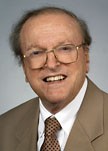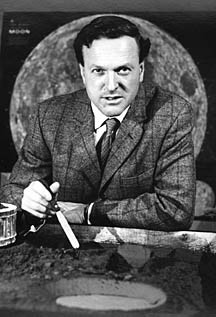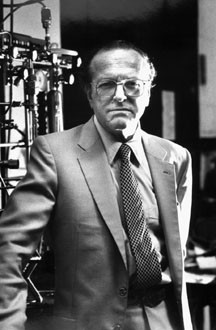Thomas Gold, Cornell astronomer and brilliant scientific iconoclast, dies at 84
By Roger Segelken
Thomas "Tommy" Gold, a brilliant and controversial figure in 20th century science and professor emeritus of astronomy at Cornell University, died June 22 at Cayuga Medical Center, Ithaca, N.Y., after a long battle with heart disease. He was 84 years of age.
Gold's reputation as a Renaissance man was surpassed only by his penchant for unconventional theories -- from the origin of the universe to the source of petroleum. Few scientists ever attempt what Gold made a career of, staking their reputations on ideas that radically challenge the methods and assumptions of an entire discipline.
Said Joseph Veverka, chairman of Cornell's Department of Astronomy and a longtime colleague: "Tommy will be remembered fondly by all of us for his incisive and provocative ideas, for his sincere dedication to his colleagues, as well as for his wide-ranging contributions to physics and astronomy extending over such varied topics as the steady-state theory of the universe, pulsars, the lunar regolith and the geochemistry of the Earth's mantle."
Famous for stirring up conflict and controversy, Gold was variously described as a "contrairian," a "maverick," and a "world-class contrarian." Gold, however, saw his departures from conventional wisdom as simply doing his job as a scientist. "I don't enjoy my role as a heretic," he once told an ABC News reporter. "It's annoying."
Indeed, despite the intense opposition they often encountered, many of Gold's most outrageous -- and passionately held -- ideas had a curious habit of turning out to be right. For example, in 1946 as a graduate student in astrophysics at Cambridge University, Gold became intrigued by a problem that was perplexing auditory physiologists at the time: Why is the human ear so good at discriminating between different musical notes? Prevailing thought held that the structures of the ear were too weak and flabby to resonate and that it was the brain -- not the ear -- that was responsible for detecting the pitch of a note. Gold disagreed and designed an elegant experiment to prove his theory that the ear was indeed capable of resonating.
His research was largely ignored until nearly 30 years later, when physiologists, armed with more refined tools, began to uncover evidence for the existence of natural amplifiers: tiny hair cells that provide feedback to vibrating membranes in the ear, enabling them to resonate. Another of Gold's ideas that encountered initial resistance was his 1967 theory about the nature of pulsars, objects in deep space that produce regularly pulsing radio waves. Gold's explanation, that pulsars are neutron stars emitting radio waves as they spin, was considered so implausible that he was not even allowed to defend it at a conference. However, the discovery of a pulsar in the Crab Nebula led to the theory's universal acceptance.
"After that, I was never going to compromise with other people's opinions again," Gold said of the pulsar debate. "Just know the facts."
He was right again in 1955 when, as one of the commanding lunar researchers of the era, he suggested that the moon's surface was covered with a fine rock powder, a view opposed by many of his scientific colleagues. He was not vindicated until the first moon landing in 1969, when the Apollo 11 crew brought the first sample of lunar soil back to Earth. Gold was one of the 110 scientists in the United States and abroad to receive the soil for analysis, and the researchers concluded that the soil on the lunar surface is indeed powdery. Its darkness, they said, is explained by a very thin coating of metal on each individual grain, caused by the penetration of the solar wind. (Gold played an important role in Apollo 11 in another respect: He designed the stereo camera carried on the lunar surface by the astronauts.)
Not all of Gold's unconventional ideas withstood the test of time. Most famously, his "steady-state" theory, for years considered by many cosmologists a possible alternative to the "big-bang" theory of the origin of the universe, is now widely regarded as a brilliant mistake. Gold developed the idea of a steady-state universe that has no beginning or end and in which matter is constantly being created, with fellow astrophysicists Fred Hoyle and Hermann Bondi while a graduate student at Cambridge.
The debate still is raging on one of Gold's last, and most widely controversial, ideas: that oil and natural gas are formed not from decaying organic matter, as most scientists believe, but from geologic processes and continually well up to the surface from deep underground.
The presence of organic molecules in all petroleum deposits has long been taken as evidence for the biological origin of petroleum. Gold argued instead in his 1999 bookThe Deep Hot Biosphere that the organic molecules come from subterranean microbes that feed on petroleum deep in the Earth's crust. Gold's vision of a supply of oil and gas that is essentially inexhaustible drew intense criticism from petroleum geologists.
Born in Vienna, Austria, in 1920, Gold received his secondary education in Switzerland and went to England shortly before World War II to study at Cambridge University, where he received his bachelor's and master's degrees. While at Cambridge, Gold spent a year in a British internment camp as a suspected enemy alien. He later worked on the development of naval radar for the British Admiralty.
Gold did not receive his doctorate -- an honorary degree -- from Cambridge until 1969, 10 years after he was hired by Cornell from Harvard University, where he was professor of astronomy. At Cornell he chaired the astronomy department and was director of the Center for Radiophysics and Space Research. Later he became assistant vice president for research. After his retirement from Cornell in 1987, he continued to publish and conduct research.
"Gold epitomized Cornell's openness to offbeat geniuses," wrote Keay Davidson in a 1999 biography of the late Carl Sagan, another Cornell scientist famous for his controversial theories. Indeed, Gold was responsible for bringing Sagan to Cornell in 1968 after the popular astronomer had been denied tenure by Harvard.
Gold was a notoriously energetic figure on Cornell's campus, refusing to take elevators and frequently startling his colleagues by leaping up stairs two at a time. His program of exercise included water-skiing, climbing and even tightrope walking. He brought this same boundless enthusiasm to his scientific research, once becoming so excited by a sample of sludge from an oil well that he analyzed it on the spot in a friend's kitchen, using ordinary household materials.
Gold received many professional honors during his career, including election to the National Academy of Sciences, and fellowships in the Royal Society (the British scientific academy) and the American Academy of Arts and Sciences. He also served on the President's Science Advisory Committee.
He is survived by his second wife, Carvel (Beyer) Gold of Ithaca, and by the couple's daughter, Lauren Gold of West Palm Beach, Fla., as well as by three daughters from his first marriage to Merle Eleanor Tuberg: Lindy Bryant of Philadelphia, Lucy Gold of Ithaca and Tanya Vanasse of Carmel, N.Y., and by six grandchildren.
Media Contact
Get Cornell news delivered right to your inbox.
Subscribe

